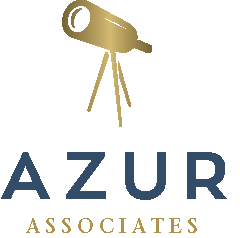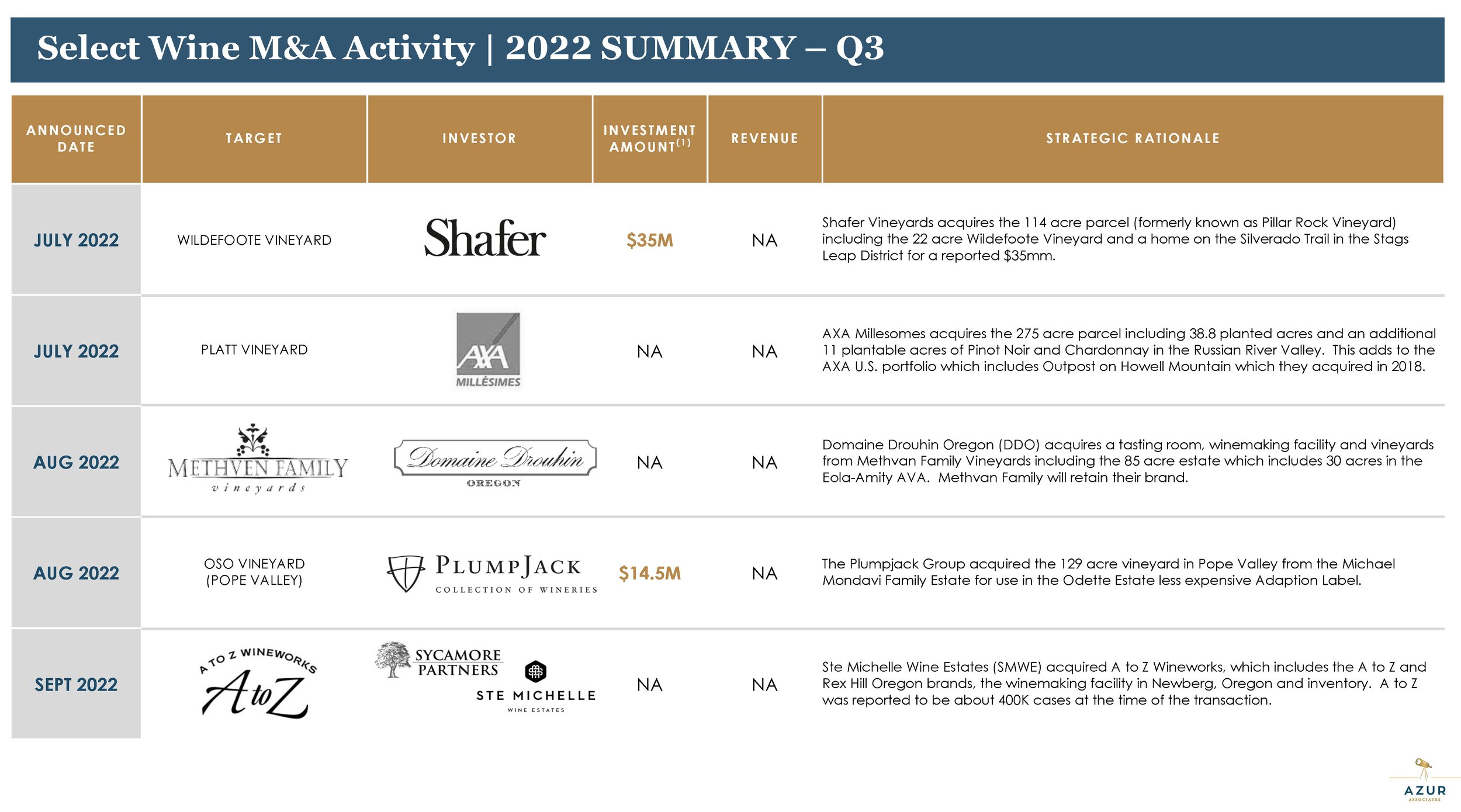Wine M&A | 2022 Summary + 2023 Outlook
2022 was more of a “return to normal” for wine M&A, with the notable exception of multiple marquee Napa Valley estate transactions. While there were some rumblings about the comparison to prior year, it is important to note that 2021 was an extraordinary year with more large company transformational transactions than in over a decade +.
2022 Summary
The 2022 wine M&A market was still very active.
The volume of notable transactions in 2022 was fairly consistent with that of 2021. Our summary of select transactions includes 25 notable deals. Transactions were spread across regions as follows:
Napa Valley (9)
Oregon (5)
Paso Robles (3)
Sonoma (1)
Washington (1)
Other – of the 25 select transactions 6 were either in other regions (e.g. Meier Beverage Group in Ohio) or not necessarily tied to a region (e.g. Hoxie Wine Spritzers)
In addition to Napa Valley, Oregon and Paso Robles, certain luxury sub-AVA’s in Sonoma (e.g. Russian River) and Washington (e.g. Walla Walla) are also on the wish list for certain buyers.
2023 Outlook
A+ Brands with excellent assets & strong cash flow will still transact
In 2022 a few of Napa Valley’s marquee estates including Shafer Vineyards and Joseph Phelps Vineyards attracted international buyers at high market valuations. This occurred at the same time two significant macro-economic factors including higher interest rates and a stronger dollar were unfolding. Even with challenging economic factors in play, the scarcity value and durable cash flows of these trophy assets is attractive to buyers.
There will continue to be demand for those fortunate enough to own these types of assets located in the right places with a mindful long-term approach to investing in vineyards, wine quality, brand and the right team.
Transaction volume will be steady but slower
As noted, our summary of select transactions was consistent in 2022 vs. 2021 with 25 in both years. That said, activity did slow down in the Q3 and Q4 of 2022. Increased interest rates, growing headwinds in wine demand and continue cost challenges have raised caution flags for buyers.
Increased caution translates to a heavier dose of risk assessment during due diligence which increases diligence time frames. Longer diligence time frames are not the friend of a seller and tend to either delay a transaction or in some cases cause a buyer to either delay a transaction or in some cases reconsider the transaction.
Higher cost of capital impacts valuations more as time goes on
The higher interest rate environment translates to a higher cost of capital. This has an impact on both the type of assets buyers are willing to pursue as well as how much they are willing to pay. As noted above, the scarcity and durable cash flows of A+ estates will attract buyers in nearly any environment. For the vast majority of other assets and brands, an increased cost of capital is directly correlated to lower valuations and in some cases drives buyers to simply walk away from deals.
As time goes on, sellers who were not satisfied with the valuations they received in 2021 and 2022 will likely be disappointed further in 2023 as long as interest rates continue to increase.
The impact is further amplified by wineries that have increasing costs on nearly all their inputs and lack the ability to offset the increased costs with higher pricing.
Premium vineyards in desirable locations are still in demand
Demand for wine at higher price tiers is still growing at a healthy pace and the higher the price the better (e.g. better >$100 than <$100). Appropriate sourcing and vineyard land for the higher priced wines is limited. Those enjoying growth due to the specific positioning of their portfolio at these higher priced tiers are still seeking best of class vineyards to help secure supply for long term growth.
The types of vineyards in demand include a strong track record of repeatable quality in locations that fit the AVA requirements for these high tier brands. While certain sub-AVA’s of Napa Valley are obvious, the same holds true for specific sub AVA’s in the regions noted in the 2022 activity.
Route to Market will continue to evolve and drive further DTC and wholesale platform M&A
The desire for continuous improvement in both Direct to Consumer (DTC) and wholesale Route to Market (RTM) efficiency has a very long runway. DTC is clearly in the “early innings” in terms of developing platforms that help navigate the balancing of the regulatory environment with consumer demand.
A number of operators and investors from outside the wine industry continue to gain a deeper understanding of the existing gaps and how to build something that is more cost-efficient and easier to use. In the end, the consumer benefits with much greater availability to choose from as well as tools to assess where they can find great value. We believe there will continue to be significant investment in software, logistics and capacity to help the consumer in this space.
The wholesale market is working on continuous improvement as well. Rarely a week or two goes by where don’t hear about larger distributors acquiring smaller ones in markets across the U.S. What is happening behind the scenes is more significant in efforts to streamline orders, warehousing and logistics across the supply chain. These efficiencies are not solely for the benefit of distributors, but rather ultimately demanded by retailers in efforts to serve the consumer more efficiently for the commercial wines in demand through those channels.
Opportunities remain for those prepared & with cash as significant industry transitions continue
The wine market is facing new challenges not seen in the last several decades. The rapidly changing younger consumer has a different attitude and approach to products in general and alcohol specifically. Wellness and overall lifestyle trends towards moderation are more long term in nature and here to stay. Other increased macro challenges including climate change, higher input costs across all input categories and difficult to find labor create a new daunting set of challenges not everyone will want to tackle.
In the U.S. the above factors are merging with a generational shift in ownership for many wineries. Generational transfers for any family business are difficult at best. The combination of the new and increased headwinds with these generational transfers will put further pressure on whether families want to continue or exit the business.
There are new entrants with great energy and new ideas about how to approach some of these challenges. Those with the ability to adjust, take the long view and with ample cash will have a significant opportunity to create value in the wine category.






